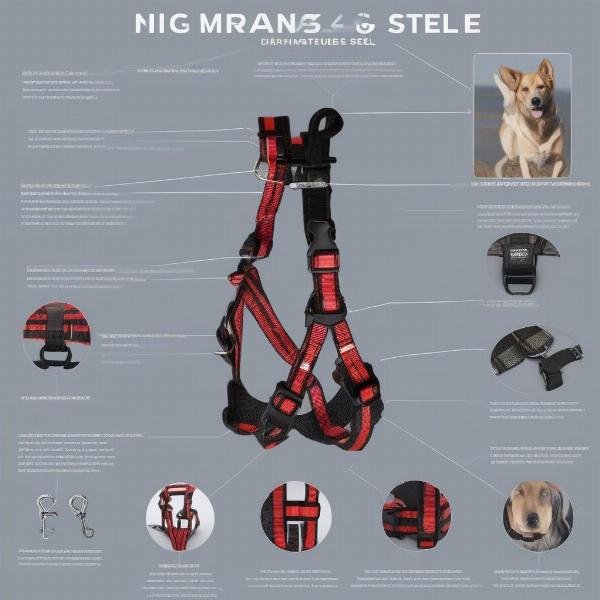Steel dog harnesses are often chosen for their strength and durability, especially for powerful breeds or dogs prone to pulling. However, selecting the right steel harness requires careful consideration of your dog’s individual needs, size, and temperament. This guide will delve into the different types of steel harnesses, their benefits and drawbacks, fitting tips, and essential safety precautions.
Understanding Steel Dog Harnesses: Types & Benefits
When choosing a steel dog harness, you’ll encounter various types designed for different purposes. Pinch/prong collars, while sometimes made of steel, are not harnesses and will not be covered in this guide. Instead, we’ll focus on body harnesses incorporating steel components. These can include harnesses with steel buckles, D-rings, or reinforced straps. One popular type is the steel tracking harness, often used for search and rescue or professional dog training. They offer superior control and are designed to withstand rigorous activity. Another type utilizes steel for reinforcement in heavy-duty harnesses meant for everyday use with strong or reactive dogs.
 Types of Steel Dog Harnesses
Types of Steel Dog Harnesses
The primary benefit of steel components in a harness is their enhanced durability. Steel is less likely to break or wear down compared to other materials like plastic or nylon, especially under stress. This makes steel harnesses a good choice for dogs that pull hard or are particularly active. They also offer added security, making them more escape-proof.
Choosing the Right Steel Dog Harness: Fit & Safety
Proper fit is crucial for both comfort and safety. A poorly fitting harness can chafe, restrict movement, or even allow your dog to escape. Measure your dog’s chest girth and neck circumference accurately and consult the manufacturer’s sizing chart. Ensure the harness allows for a comfortable range of motion without being too loose.
Safety is paramount when using a steel dog harness. Never leave your dog unattended while wearing a harness, especially a steel one, as it could become entangled and pose a strangulation risk. Regularly inspect the harness for any signs of damage, such as broken buckles or frayed straps. Avoid using steel harnesses in extreme heat, as the metal can absorb heat and potentially burn your dog.
Training and Activities with a Steel Dog Harness
Steel harnesses can be beneficial for training, particularly for dogs that pull excessively. A front-clip harness with steel components can help redirect pulling, while a back-clip harness provides more control for walking and other activities. For activities like tracking or scent work, a specialized steel tracking harness is often preferred.
Remember that training involves more than just the right equipment. Positive reinforcement techniques are crucial for effective and humane training. Consult a certified professional dog trainer for personalized guidance.
Maintaining Your Steel Dog Harness
Steel harnesses are generally low-maintenance, but proper care can extend their lifespan. Clean the harness regularly with a damp cloth and mild soap. Rinse thoroughly and allow to air dry completely before use. Avoid submerging the harness in water, as this can lead to rust. Inspect the buckles, D-rings, and straps frequently for any signs of wear and tear.
Conclusion
Steel dog harnesses offer durability and control, making them a suitable choice for specific needs and activities. However, proper fit, safety precautions, and responsible training are essential for ensuring the well-being of your dog. By understanding the different types of steel harnesses and following these guidelines, you can make an informed decision and provide your dog with a safe and comfortable experience.
FAQ
-
Are steel harnesses safe for all dogs? While generally safe, steel harnesses are not suitable for all breeds or situations. Consult with a veterinarian or professional dog trainer to determine if a steel harness is right for your dog.
-
How do I clean a steel dog harness? Clean with a damp cloth and mild soap, rinse thoroughly, and air dry completely.
-
Can a steel harness hurt my dog? A properly fitted steel harness should not hurt your dog. However, an ill-fitting harness can chafe or restrict movement.
-
What type of steel harness is best for pulling? A heavy-duty harness with steel reinforcement is often recommended for dogs that pull.
-
Are steel harnesses good for training? Yes, steel harnesses can be helpful for training, especially for dogs that pull excessively.
-
Can I leave my dog unattended while wearing a steel harness? No, never leave a dog unattended while wearing any harness, especially one made of steel.
-
Where can I buy a quality steel dog harness? Reputable pet stores and online retailers specializing in dog equipment offer a variety of steel harnesses.
About ILM Dog
ILM Dog is your trusted source for comprehensive information on dog care, breeds, training, health, and accessories. We are dedicated to providing expert advice and practical tips to help dog owners worldwide provide the best possible care for their canine companions. Our expertise covers a wide range of topics, from choosing the right breed to understanding dog behavior and providing optimal nutrition. Whether you’re a seasoned dog owner or just starting your journey, ILM Dog is here to support you every step of the way. Contact us today for personalized advice! Email: [email protected], Phone: +44 20-3965-8624.